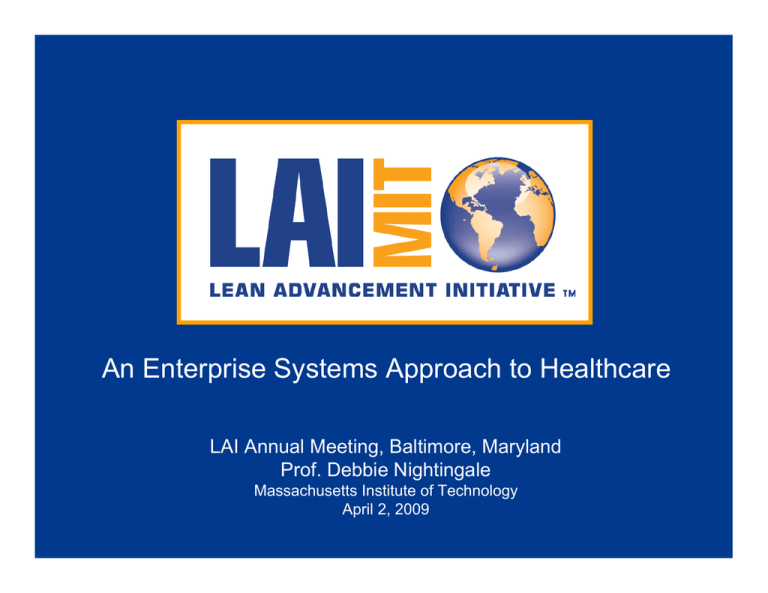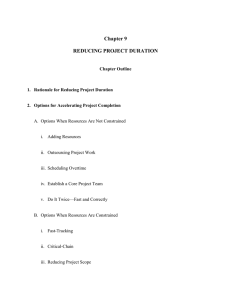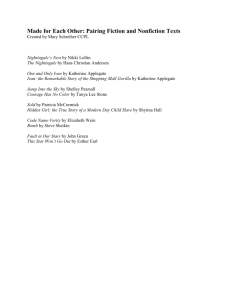An Enterprise Systems Approach to Healthcare LAI Annual Meeting, Baltimore, Maryland
advertisement

An Enterprise Systems Approach to Healthcare LAI Annual Meeting, Baltimore, Maryland Prof. Debbie Nightingale Massachusetts Institute of Technology April 2, 2009 Agenda • Research Motivation • Cross-Industry Enterprise Challenges • Boston Provider Case Examples • LAI Enterprise Healthcare Vision http://lean.mit.edu © 2009 Massachusetts Institute of Technology D. Nightingale 4/2/09 - 2 Research Motivation Life Expectancy at Birth and GDP Per Capita Over 16% of US GDP spent in healthcare expenses Cost 2005 OECD Data Hospital care represents 30.8% of total expenditure 49% of expenditure concentrated in only 5% of population Individuals over 65 years old expected to increase over 50% by 2020 98,000 deaths attributed to medical errors Quality Adults on average only receive 55% of recommended care Emergency Departments are overcrowded nationwide Provider fragmentation unable of creating sufficient volume 45 million Americans are uninsured Access Fragmented provider network, 75% being small or single practices Recent survey indicated 40% of Americans received uncoordinated care Fragmented payment systems, health plans, information systems, etc http://lean.mit.edu © 2009 Massachusetts Institute of Technology D. Nightingale 4/2/09 - 3 Agenda • Research Motivation • Cross-Industry Enterprise Challenges • Boston Provider Case Examples • LAI Enterprise Healthcare Vision http://lean.mit.edu © 2009 Massachusetts Institute of Technology D. Nightingale 4/2/09 - 4 Cross Industry Enterprise Challenges Aerospace • Overarching commitment to ensure global peace and security • Incumbent higher, faster, farther mindset • Declining defense dollars after Cold War (fewer military aircraft programs; industry consolidation) • Inherently complex industry: Healthcare • Overarching commitment to provide world class medical care • Incumbent overuse, underuse, and misuse mindset • Overburdened healthcare expenditure as a % of GDP (proliferation of fragmented disjointed providers) • Inherently complex industry • Multiple stakeholders with misaligned • Multiple stakeholders with misaligned objectives and numerous constraints objectives and numerous constraints • Capital Intensive • Complex product development • Uncertain outcome in contract awarding http://lean.mit.edu • Capital Intensive • Complex service provision • Uncertain outcome in value sharing © 2009 Massachusetts Institute of Technology D. Nightingale 4/2/09 - 5 LAI - A Consortium Dedicated To Cross Industry Enterprise Performance • Enable Enterprises to effectively, efficiently and reliably create value in a complex and dynamic environment • Enable focused and accelerated transformation of complex enterprises • Collaborative engagement of all stakeholders in Government, Industry and Academia • Understand, develop, and institutionalize principles, processes, behaviors and tools http://lean.mit.edu © 2009 Massachusetts Institute of Technology D. Nightingale 4/2/09 - 6 Agenda • Research Motivation • Cross-Industry Enterprise Challenges • Boston Provider Case Examples • LAI Enterprise Healthcare Vision http://lean.mit.edu © 2009 Massachusetts Institute of Technology D. Nightingale 4/2/09 - 7 Boston Provider Case Examples A Primary Care Satellite of a Hospital Provider For profit Hospital Provider owns 5 primary care satellites that refer patients to main hospital Case 1 Problem statement: Considerable amount of patient “no shows” Backlog of patients scheduled for appointments Capacity constraints An Emergency Department of a Hospital Provider Non profit Hospital Provider contracts with 11 primary care satellites and owns 3 hospitals Case 2 Problem statement: Emergency Department waiting time is considerable Staff low moral leading to churning Patients leaving without being seen Case 3 http://lean.mit.edu The New England Veterans Affairs Medical Center © 2009 Massachusetts Institute of Technology D. Nightingale 4/2/09 - 8 Case 1: A Primary Care Satellite of a Hospital Provider Primary Care Satellite • Owned by main hospital provider • Refers patients to main hospital services • Physicians are not salaried Hospital Provider • Has patients from multiple insurance companies • Has multiple referral primary care satellites Patients Insurer A Satellite A Hospital Physicians http://lean.mit.edu Satellite B Insurer B Insurer C Who is the customer? • Satellite administration concerned with attracting physicians and patients • Physicians concerned with patient care • Hospital concerned with insurers What are the metrics? • Insurers focus on different sets of metrics related to costs & preventive care • Hospital focuses on total patient visits per satellite • Satellite focuses on total patient waiting time and physician utilization What are some of the systemic issues? • Hospital attempts to satisfy different metrics from different insurers • Hospital sets quality of care at a minimum (i.e. what insurance wants) and foregoes continuous improvement • Satellite focuses on total throughput and neglects departmental variability • Patients don’t feel the burden of care costs, are unhappy with wait times, and contribute to no show rate © 2009 Massachusetts Institute of Technology D. Nightingale 4/2/09 - 9 Hospital Satellite as a Lean Enterprise Assessment Recommendations Strategic Direction Setting No No clear clear strategic strategic objectives objectives Objectives Objectives should should be be well well understood, understood, actionable, actionable, and and measurable measurable Stakeholder Focus Focus Focus is is primarily primarily on on enterprise enterprise shareholders shareholders Shift Shift focus focus from from shareholders shareholders to to stakeholders stakeholders Measurement Current Current metrics metrics do do not not gauge gauge enterprise enterprise performance performance Knowledge Management Infrastructure Infrastructure for for cross -department cross-department knowledge knowledge sharing sharing not not in in place place today today http://lean.mit.edu Lean Transition Metrics Metrics need need to to be be consistent consistent and and standard standard Cross Cross functional functional // Cross Cross departmental departmental knowledge knowledge review review forums forums © 2009 Massachusetts Institute of Technology D. Nightingale 4/2/09 - 10 Case 2: An Emergency Department of a Hospital Provider Emergency Department (ED) is struggling to keep up with the demand for its services. • Waiting room is constantly full with long delays. • Patients requiring hospital admittance often experience additional delays. • Some patients leave without being seen. • The ED is the only safety net for the whole hospital, and lacks one of its own. What can be done to speed patient flow in the Emergency Department? Where should a process improvement initiative focus? • Finger pointing and lack of communication between ED and other units. • ED Staff are strained to the limit. http://lean.mit.edu © 2009 Jorge Fradinho Oliveira © 2009 Massachusetts Institute of Technology D. Nightingale 4/2/09 - 11 Multi-Attribute Model Provides Framework for Evaluating Emergency Department Policy / External Factors Process Process Organization Organization Products / A Services Strategy Knowledge Knowledge Info/Infrastructure http://lean.mit.edu © 2009 Nightingale/Rhodes © 2009 Massachusetts Institute of Technology D. Nightingale 4/2/09 - 12 Hospital Enterprise Architecture Uninsured population; primary care Diagnostic unavailability; safety net compromised; Non standardized admitting process; patient boarding (i.e. admitted patients held in ED due to lack of inpatient beds); costly bolt ons fee for service payment model Policy / External Factors Process Process Focus on revenue generating elective surgery; 16 strategic objectives; ED absent of strategic plan Timely provision of care compromised; overall hospital image compromised Organization Organization Products / A Services Strategy Knowledge Knowledge Low staff morale; physician cultural rifts; high volume of staff churning; lack of productivity; finger pointing between ED and elsewhere Source: Jorge Fradinho Oliveira Info/Infrastructure Fragmented information systems; costly proprietary software http://lean.mit.edu © 2009 Nightingale/Rhodes Reliance on heroes and bed czars; incomplete patient record; high variation of evidence based medicine within and across providers © 2009 Massachusetts Institute of Technology D. Nightingale 4/2/09 - 13 Case 3: New England Veterans Affairs Partnership and Preliminary Insights Evolving recent partnership between LAI and the New England Veterans Administration (VISN 1) Rationale Context • Richness of VA enterprise dataset which is shared across multiple regions • Ability to control for potential misaligned behavior induced by traditional commercial and public healthcare payment models • “It is not impossible to get your head around the processes and activities in health care. Performance, demand, and structure can be modeled and can be used to improve the enterprise.” Emergency Services Insights • Non‐VA ER Transfer Non‐Emergency “Even if profit is not a significant factor, it is still worthwhile creating and ESAT Analysis Yielded understanding your strategic goals and using them to drive your enterprise forward.” Multiple Insights Walk‐In to Outpatient VA ER Transfer Referral from Primary Care VA Urgent Care Transfer Enabling Infrastructure • Inpatient Treatment Residential Programs Purchasing Substance Abuse Patient Data Mgmt PTSD Women Outpatient Treatment General Mental Health Scheduling Quality Assurance Community Residential Chronic Care Domiciliary Treatment Bedford Stabilization Program • Payroll Human Resources “We must align the enterprise on all levels and empower management on all levels with an understanding of the greater strategic goals.” Brockton http://lean.mit.edu Research “It is not enough just to serve patients as they enter, we must also plan ahead in health care, and work towards being proactive rather than re-active.” Acute Care Jamaica Plain West Roxbury Outpatient Clinics Outside the Enterprise © 2009 Massachusetts Institute of Technology D. Nightingale 4/2/09 - 14 Agenda • Research Motivation • Cross-Industry Enterprise Challenges • Boston Provider Case Examples • LAI Enterprise Healthcare Vision http://lean.mit.edu © 2009 Massachusetts Institute of Technology D. Nightingale 4/2/09 - 15 LAI Enterprise Healthcare Vision In 1992 US Air Force asked: Can the concepts, principles and practices of the Toyota Production System (TPS) be applied to the military aircraft industry? MIT answered: YES! Over a decade of significant research was conducted well beyond TPS to the Enterprise system level and ultimately delivering superior results for aerospace commercial and governmental sectors ? In 2008 the Healthcare Community asks: Can the concepts, principles and practices of Lean Enterprise Value be applied to the healthcare industry? Our Research to date says: YES! http://lean.mit.edu © 2009 Massachusetts Institute of Technology D. Nightingale 4/2/09 - 16







